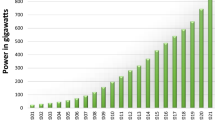Abstract
When the wind power electricity system working above the rated wind speed, the disturbed wind speed can lead to the output ripple easily, which causes a significant negative influence on the stability of the power grid. In order to overcome this disadvantage, this paper discusses the mixed \(H_2/H_{\infty }\) pitch angle control design problem for the nonlinear wind turbine generator system, where the turbulence is regarded as the disturbance input. Especially, the global exact linearization and the pole placement techniques are also applied to guarantee the desired control performance and expected dynamic characteristics in the situation of a large-scale variety of the system operation points. The simulation results show the effectiveness of the proposed method.












Similar content being viewed by others
References
GWEC, Global wind 2014 report. http://www.gwec.net/
Muyeen SM (2012) Wind energy conversion systems: technology and trends. Springer, Berlin
Jha AR (2011) Wind turbine technology. CRC Press, Florida
Mathew S, Philip GS (2011) Advances in wind energy conversion technology. Springer, Berlin
Munteanu L, Bratcu AL, Cutuluis NA (2008) Optimal control of wind energy systems. Springer, London
Senjyu T, Sakamoto R, Urasaki N et al (2006) Output power leveling of wind turbine generator for all operating regions by pitch angle control. IEEE Trans Energy Convers 21:467–475
El-Tous Y (2008) Pitch angle control of variable speed wind turbine. Am J Eng Appl Sci 2:118–120
Lescher F, Zhao JY, Borne P (2005) Robust gain scheduling controller for pitch regulated variable speed wind turbine. Stud Inform Control 14:299–315
Bianchi FD, Mantz RJ, Christiansen CF (2005) Gain scheduling control of variable speed wind energy conversion systems using quasi-LPV models. Control Eng Pract 13:247–255
Balas MJ, Wright A, Hand M et al (2003) Dynamics and control of horizontal axis wind turbines. In: The American control conference, Denver, Colorado, USA, pp 3781–3793
Slotha C, Esbensenb T, Stoustrup J (2011) Robust and fault-tolerant linear parameter-varying control of wind turbines. Mechatronics 21:645–659
Bianchi FD, Battista HD, Mantz RJ (2007) Wind turbine control systems principles, modelling and gain scheduling design. Springer, Netherlands
Isidri A (1995) Nonlinear control system. Springer, Berlin
Khalil HK (2002) Nonlinear system. Prentice Hall, London
Cheng D, Isidori A, Respondek W, Tarn TJ (1988) Exact linearization of nonlinear systems with outputs. Math Syst Theory 21:63–83
Lin ZW, Lin Y, Zhang WH (2009) A unified design for state and output feedback \(H_{\infty }\) control of nonlinear stochastic Markovian jump systems with state and disturbance-dependent noise. Automatica 41:2955–2962
Lin ZW, Liu JZ, Zhang WH, Niu YG (2011) Stabilization of interconnected nonlinear stochastic Markovian jump systems via dissipativity approach. Automatica 47:2796–2800
Liu J, Meng H, Hu Y et al (2015) A novel MPPT method for enhancing energy conversion efficiency taking power smoothing into account. Energy Convers Manag 101:738–748
Su X, Wu L, Shi P et al (2014) A novel approach to output feedback control of fuzzy stochastic systems. Automatica 50(12):3268–3275
Wang J (2014) Adaptive fuzzy control of direct-current motor dead-zone systems. Int J Innov Comput Inform Control 10(4):1391–1399
Su X, Shi P, Wu L et al (2013) A novel control design on discrete-time Takagi–Sugeno fuzzy systems with time-varying delays. IEEE Trans Fuzzy Syst 21(4):655–671
Wu L, Su X, Shi P (2015) Fuzzy control of nonlinear electromagnetic suspension systems. In: Fuzzy control systems with time-delay and stochastic perturbation. Springer International Publishing, Berlin, pp 289–307
Li YM, Tong SC, Li TS (2015) Observer-based adaptive fuzzy tracking control of MIMO stochastic nonlinear systems with unknown control direction and unknown dead-zones. IEEE Trans Fuzzy Syst 23(4):1228–1241
Li YM, Tong SC, Liu YJ, Li TS (2014) Adaptive fuzzy robust output feedback control of nonlinear systems with unknown dead zones based on small-gain approach. IEEE Trans Fuzzy Syst 22(1):164–176
Mistler V, Benallegue A, M’Sirdi NK (2001) Exact linearization and noninteracting control of a 4 rotors helicopter via dynamic feedback. In: IEEE international workshop on robot and human interactive communication, Bordeaux, Paris, pp 586–593
Chang LY, Chen HC (2014) Linearization and input–output decoupling for nonlinear control of proton exchange membrane fuel cells. Energies 7:591–606
Famouri P (1992) Control of a linear permanent magnet brushless dc motor via exact linearization methods. IEEE Trans Energy Convers 7:544–551
Chilali M, Gahinet P (1996) \(H_{\infty }\) design with pole placement constrains: an LMI approach. IEEE Trans Autom Control 41:358–367
Chilali M, Gahinet P, Apkarian P (1999) Robust pole placement in LMI regions. IEEE Trans Autom Control 44:2257–2270
Hassan HM, ElShafei AL, Farag WA, Saad MS (2012) A robust LMI-based pitch controller for large wind turbines. Renew Energy 4:63–71
Salle SA, Reardon D, Leithead WE, Grimble MJ (1990) Review of wind turbine control. Int J Control 52:1295–1310
Abdin ES, Xu W (2000) Control design and dynamic performance analysis of a wind turbine-induction generator unit. IEEE Trans EC 15:91–96
Golnaraghi F, Kuo BC (2010) Automatic control system, 9th edn. Wiley, USA
Dou ZL, Cheng MZ, Ling ZB et al (2010) An adjustable pitch control system in a large wind turbine based on a fuzzy-PID controller. In: International symposium on power electronics electrical drives automation and motion, pp 391–395
Author information
Authors and Affiliations
Corresponding author
Additional information
This work is partially supported by the National Basic Research Program of China (973 Program) (Grant No. 2012CB215203), the National Natural Science Foundation of China (No. 61203043, No. 51036002) and the Fundamental Research Funds for the Central Universities.
Rights and permissions
About this article
Cite this article
Zhu, M., Liu, J., Lin, Z. et al. Mixed \(H_2/H_{\infty }\) pitch control of wind turbine generator system based on global exact linearization and regional pole placement. Int. J. Mach. Learn. & Cyber. 7, 921–930 (2016). https://doi.org/10.1007/s13042-016-0519-x
Received:
Accepted:
Published:
Issue Date:
DOI: https://doi.org/10.1007/s13042-016-0519-x




